John Orville Chapman
1921-1980
John Orville Chapman was born January 23, 1921 in Big Creek Towhnship, Sebastian Co., Ar. to
Perry John & Maude Malissa Floyd Chapman. April 14, 1941 John married
Eva Jeanne Cheek from Barling, Sebastian Co., Ar. Sept 2, 1944 they were divorced.
On January 13, 1947 he married Mrs. Audrey Anna Welhoelter McGraw
at Fort Smith, Sebastian Co., Ar. 3 Jun 1961 he married Mercedes Jean Zamboin.
John enlisted in the Navy September 6, 1943, serving till December 4, 1945.
During that time he was assigned to the USS Twining. His rank was Radarman 2nd class - RdM2.
Below is some of the story of Twining during the time John served along with 2 musters mentioning John.
John Orville Chapman passed away June 2, 1980 and is buried at Forest Hill
Cemetery in Emmet, Nevada Co., Arkansas.
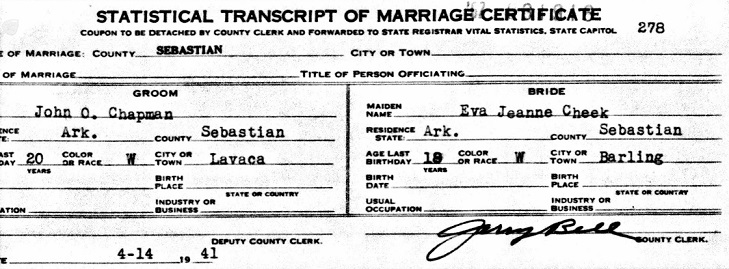
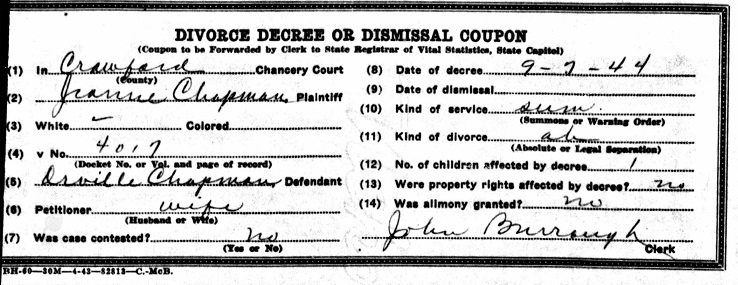

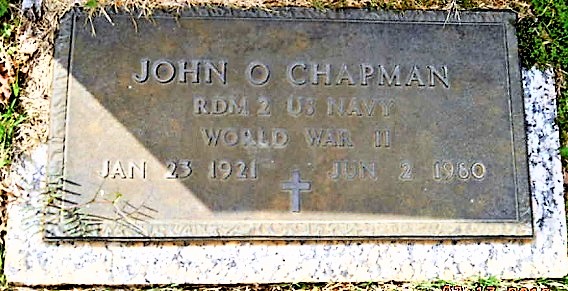
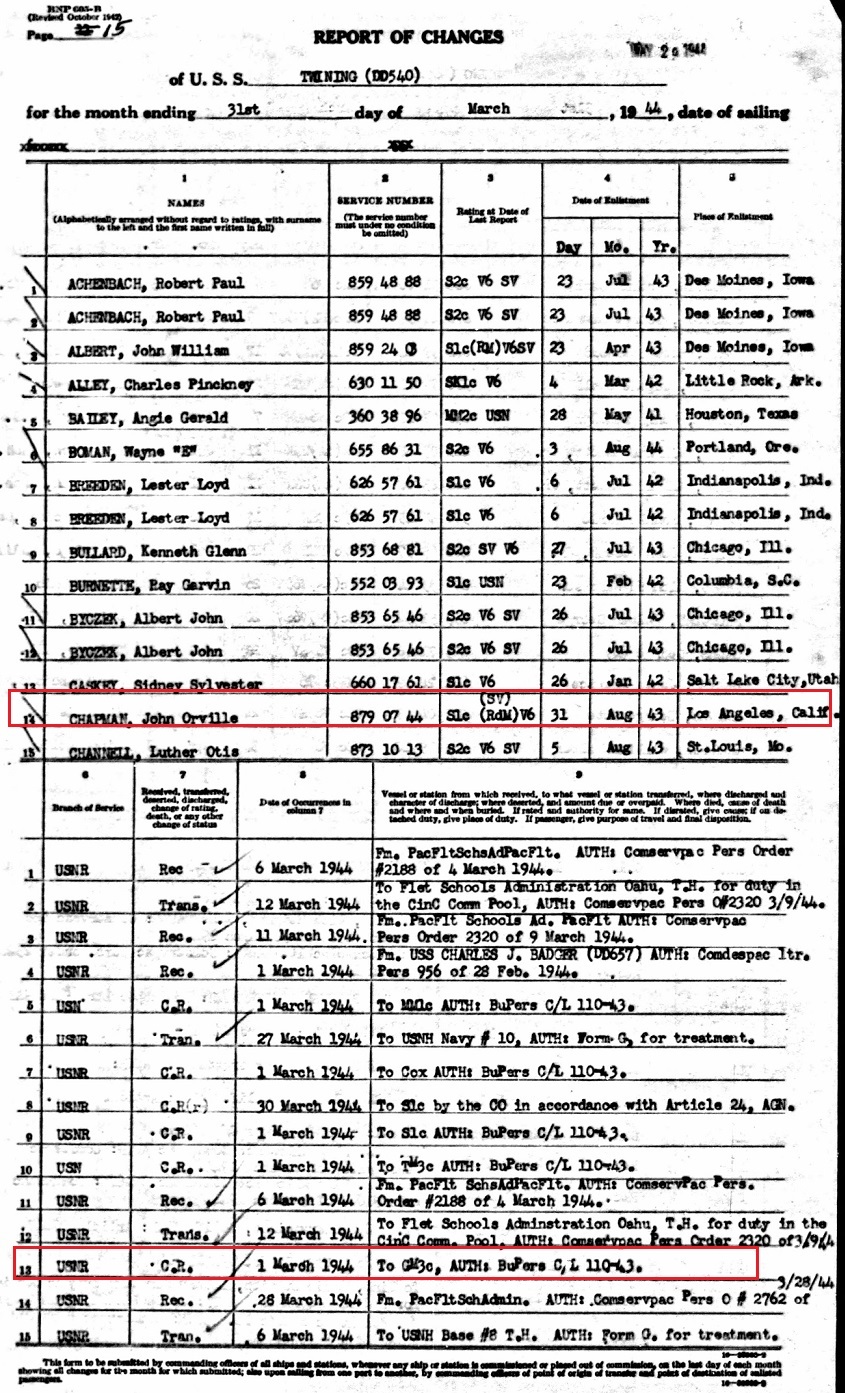
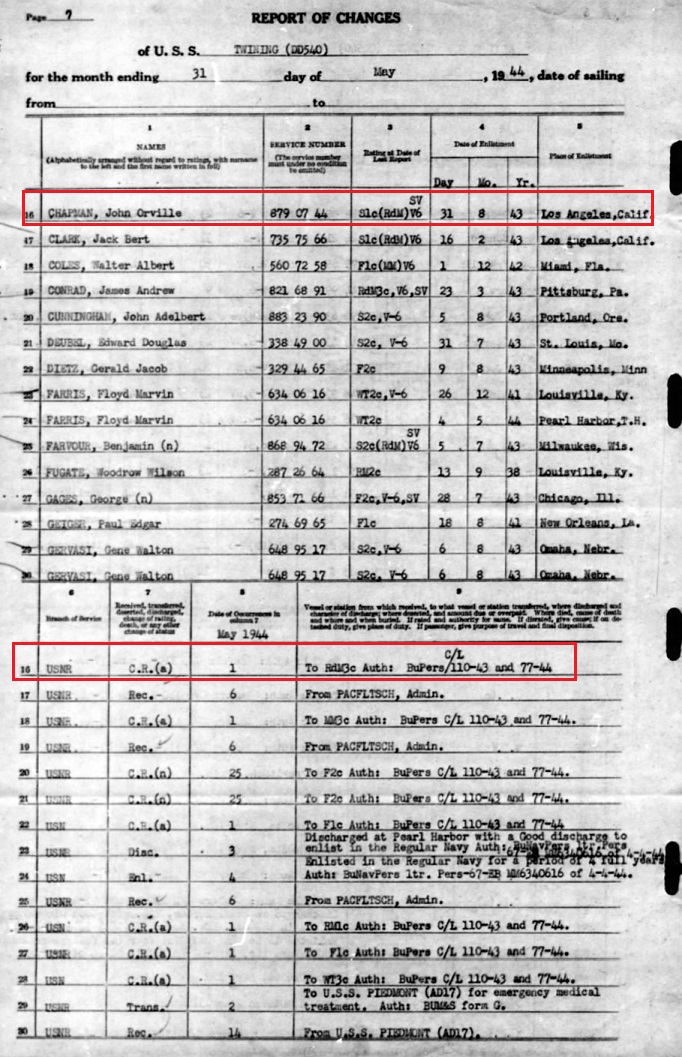
USS Twining 1944
Twining arrived at Pearl Harbor on the 17th to begin three months of training exercises,
maneuvers, and drills, as her crew honed its skills in bombardment, fire support, and
amphibious landing operations in preparation for Operation Forager. On 31 May, the
destroyer departed the Hawaiian Islands in company with Fire Support Group 1 of the
Saipan invasion forces. She arrived at Kwajalein on 8 June, fueled, and commenced
antisubmarine patrols off the harbor entrance. On the 10th, Twining screened the
sortie of the task group from the lagoon; headed for the Marianas; and arrived off
Saipan at dawn on the 14th. Steaming off the island's eastern shore, she screened
cruiser Montpelier; joined briefly in the pre-assault bombardment and, late in the
afternoon, engaged in a running battle with a coastal battery. Leading Stockham and
Montpelier, Twining closed the shore to 3,000 yards and joined in the fire which
silenced the enemy guns. As darkness fell, she took up her station to screen vessels
supplying night harassment fire at Garapan on Saipan's west coast.
The next day, D-Day, she continued screening duties and fired on selected shore targets
while marines landed on the western side of the island. Japanese planes appeared at
dusk, but none came within range of Twining's guns. She spent most of the 16th in the
unproductive pursuit of a sound contact and, at dusk, joined in the bombardment of
Magicienne Bay. During the night, her guns scored hits on a Japanese ammunition dump
near Aslito airfield.
Early on the morning of 17 June, Twining joined Destroyer Division 106 and steamed to
rendezvous with Vice Admiral Willis A. Lee's battleships in anticipation of fleet action.
The American assault on the Marianas had drawn the Japanese Combined Fleet northward
for an attempt to repulse the thrust.
The 18th passed uneventfully except for sightings of a few snoopers. Then, at dawn the
next day, a lone, unidentified plane closed the formation; took fire from Twining and
others; circled; and disappeared. The ensuing lull lasted until 10:08 when Alabama
reported a large number of aircraft approaching from the west. Steaming on picket
station 10 miles (18 km) west of the formation, Twining caught sight of the first
wave of attackers at 10:49. Throughout the battle, combat air patrol (CAP) planes
disrupted the enemy onslaught, shooting down many Japanese aircraft and thwarting the
approach of the rest. In her first antiaircraft action, Twining splashed two of the
planes which got through and also was credited with an assist. During the attacks,
the destroyer was the target of two bomb drops but suffered no damages. For Twining,
the Battle of the Philippine Sea was over in 26 minutes. No further Japanese planes
attacked nearby during the day, although pilots from the American aircraft carriers
continued to pick off intruders.
On the 20th, Twining steamed west in search of the enemy fleet. Late in the day, the
carriers launched an air strike; and, when darkness came, many planes had not returned.
Twining turned on her searchlight as a marker for the aircraft and rescued survivors of
planes which had gone down in the darkness. At dark on the 21st, the task force abandoned
the pursuit of the elusive Japanese fleet and reversed course, steaming eastward to look
again for survivors of the air strike force caught by darkness of the day before. On the
23d, Twining fueled at sea; then set course for the Marianas, screening oiler Cahaba.
At Saipan again on the 25th, Twining conducted shore bombardment off Mutcho Point.
Throughout the remainder of June, she continued to operate off Saipan, providing shore
bombardment, night harassment and illumination fire, as well as screening transports
and engaging enemy aircraft. In Magicienne Bay early on the evening of the 28th,
Twining, witnessed an impressive exchange of fire between marine units on the south
side of the bay and Japanese on the north. Later in the evening, Japanese planes
attacked, peppering seaward waters with bombs. Observers on board the destroyer
watched as shore fire scored a hit on an enemy plane overhead; then saw the plane fall
in flames some four miles away. Just before midnight on 30 June, as Twining patrolled
off Nafutan Point, two enemy planes attempted to make runs on Aslito airfield but were
turned back by heavy fire from the destroyer.
Into July, Twining continued her duties off Saipan, supplying screening, fighter
direction, and fire support. She also made occasional voyages to Tinian for bombardment
missions. Off the northern tip of Saipan on the night of 6 and 7 July, Twining's crew
was kept busy firing on numerous Japanese airplanes which had apparently chosen the
ship both as a reference point for their approach to the runway on Marpi Point and
as a target for their bombs. Nine planes made approaches during this raid, although
only one dropped a bomb. Flares from the planes often illuminated the scene as the
destroyer's gunfire drove off all nine, none of which managed to land on the
Japanese held airstrip. In the days that followed, Twining remained on picket station,
occasionally firing on enemy troop concentrations on the island.
On 24 July, she screened Montpelier and New Orleans as they shelled Japanese positions
on Tinian. The following day, the destroyer fired support missions to screen American
troops advancing up the western shore of the island. Twining continued her support of
the invasion of Tinian through the end of the month, steaming on station between Tinian
and Saipan and occasionally firing at Japanese targets on the island.
On 1 August, Twining moved to a new fire support assignment off the southeast coast of
Tinian. She made the first of three bombardment runs at 01:30 and later stood in to
1,500 yards from shore to pound enemy-held slopes and caves with gunfire. On the 7th,
Twining departed Saipan, escorting slow-moving LST-130 to Eniwetok. A week later, she
entered the atoll where her worn strut bearings were replaced.
Twining departed Eniwetok on 15 September to rendezvous with Rear Admiral Gerald F.
Bogan's Fast Carrier Task Group (TG 38.2) and thereafter devoted most of her effort
for the rest of the war to protecting aircraft carriers. Arriving off Luzon on the 21st,
Twining guarded the carriers as they launched strikes despite cloudy weather, squalls,
and low visibility. Following the launching of further strikes from an attack position
off San Bernardino Strait on the 24th, the task group headed eastward and arrived off
Saipan on the 28th. From there, the destroyer conducted antisubmarine patrols until
the 30th when the task group got underway for the western Carolines and entered Ulithi
lagoon on 6 October.
At dusk on the l1th, the task force sortied to get into a position for a strike on
Formosa, the first in a series of raids intended to destroy the usefulness of that
highly fortified island as an air base and a staging area for Japanese forces during
the impending landings on Leyte.
For three days, planes from the carriers hit targets on Formosa; and, each evening,
Japanese raiders attacked the American ships. On the 12th, Twining rescued several
downed fliers. That evening, enemy planes attacked her formation in an action which
continued until midnight. A Japanese plane threatened the destroyer from an altitude
of 300 feet. After Twining opened fire, the raider attempted to crash into her but
rapidly lost altitude and splashed 300 yards off her port bow, spreading flaming
gasoline over water near the ship.
In the days that followed, enemy air activity continued to be heavy. On the 14th, an
enemy bomber dropped two bombs which narrowly missed the destroyer.
On the 18th and 21st, the carriers of TG 38.2 launched strikes against targets in the
Philippines to support American landings on Leyte. Before dawn on the 24th, reports of
American plane sightings of the Japanese Fleet began to reach the destroyer. That day,
as Twining continued her routine screening duties, planes from the carriers struck
telling blows against Admiral Takeo Kurita's "Center Force" in the Sibuyan Sea.
That night, her task force turned north to attack a Japanese carrier force which had
been sighted north of Luzon. Daylong strikes launched from the American flattops sank
four enemy carriers of Admiral Jisaburo Ozawa's Northern Force in an action known as
the Battle off Cape Engaon. On the 26th planes from TG 38.2 attacked crippled
Japanese ships in the Visayan Sea. On the 29th, Twining rescued a downed flier from
Hancock.
But for occasional runs to Ulithi for ammunition, Twining remained with the carriers
throughout November as they hammered Japanese fortifications in the Philippines. On 10
December, the destroyer got underway with Rear Admiral Montgomery's Fast Carrier Task
Group to act as picket during strikes on Luzon in support of the landings on Mindoro.
On the 14th, she rescued a pilot from Hornet and had him on board four and one-half
minutes after his plane hit the water.
On the 17th, in rapidly worsening weather conditions, the formation rendezvoused with
fueling units; and Twining filled her oil tanks. During a typhoon which battered the
task force the next day, the weight of her full load of fuel gave Twining the added
stability she needed to weather 65-foot seas and 50-degree rolls. Ordered to stand by
the disabled Monterey as the light carrier burned, dead in the water, Twining maintained
a position near the stricken vessel throughout the storm. Twining came through the
tempest with no major damage but lost one man overboard.
As dawn broke in moderating weather on 19 December, the destroyer accompanied the task
force as it steamed on for a strike on Luzon; but, when bad weather aborted the strike,
she returned to the scene of the typhoon to search for survivors from the three
destroyers which had sunk during the storm, before returning to Ulithi on Christmas
Eve to repair storm damage.
USS Twining
.jpg)
|
|
|
|